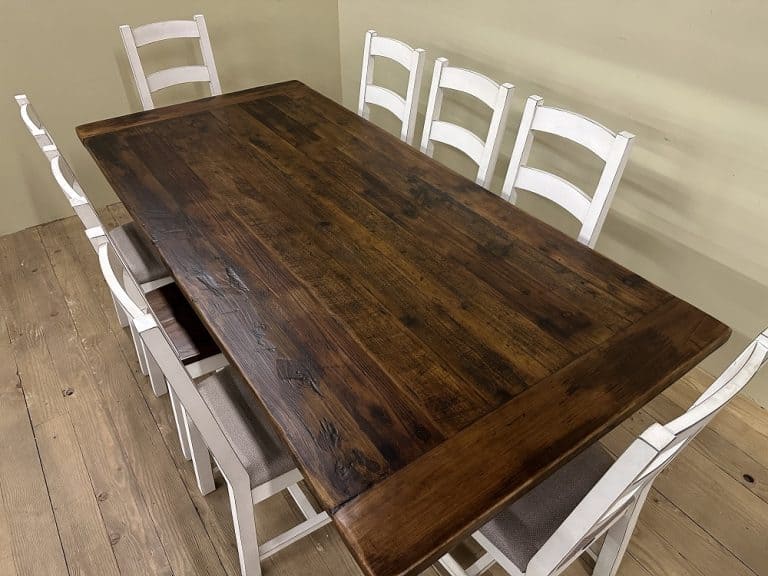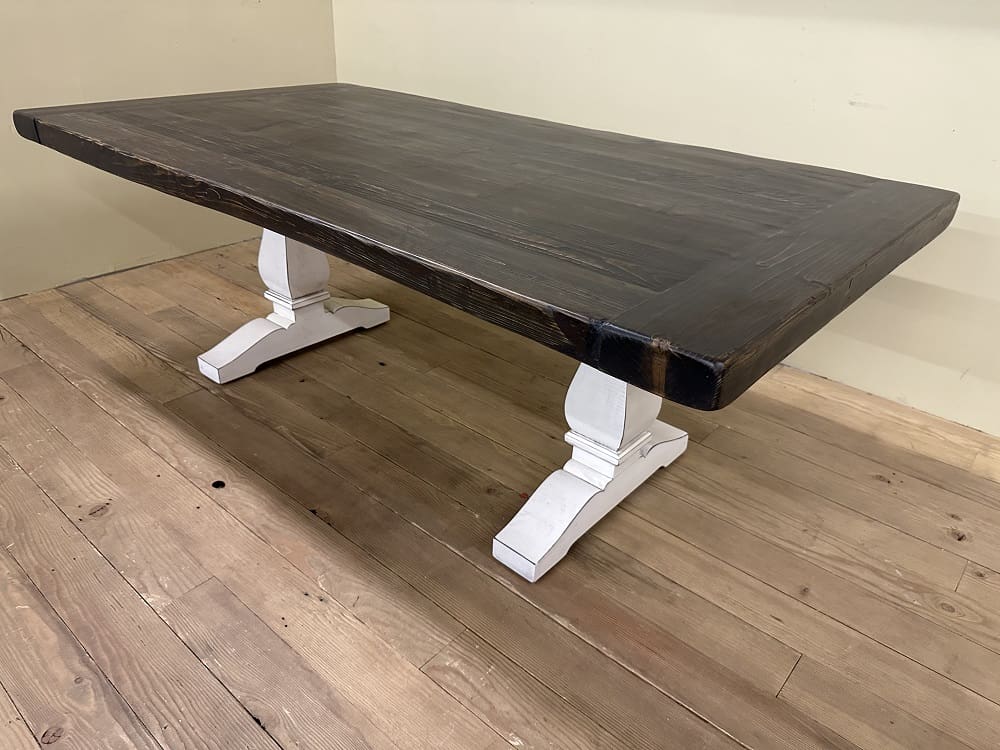Tips for Mixing and Matching Furniture in a Rustic Dining Room
Table of Contents

The rustic design aesthetic is often characterized by its warm, organic, and natural elements. This charming style, typically abundant with timeworn textures, raw wood finishes, and a cozy earth-toned color palette, perfectly encapsulates the essence of countryside living.
When it comes to infusing your dining room with a rustic vibe, mixing and matching furniture is vital. It creates an eclectic, lived-in look that lies at the heart of rustic charm. The beauty of this approach is that it allows you to blend various textures, shapes, and styles. It encourages creativity and individuality, allowing each piece of furniture to tell its own story. The juxtaposition of different pieces not only adds visual interest but also creates a comfortable and welcoming atmosphere, making every meal an unforgettable experience.
Understanding the Rustic Aesthetic
The rustic aesthetic is like a homage to the simplicity and rugged beauty of our pastoral past. It brings in elements that are raw, unpretentious, and steeped in a quiet elegance that comes from its close association with nature and traditional handicrafts. Simplicity combined with rugged sophistication forms the ethos of this design language, making it popular among interior design enthusiasts who appreciate the charm of the old-world.
Key Characteristics of Rustic Design
Rustic design is defined by a few key elements. Rough, raw, and unprocessed finishes are a hallmark, particularly when it comes to wood and stone. Colors are generally subdued and drawn from a natural palette – think rich browns, leafy greens, and earthy neutrals. Textures play a vital role too, with a strong emphasis on natural fibers, distressed finishes, and handcrafted details. All these components together create a sense of warmth and hominess that is intrinsic to the rustic aesthetic.
The Role of Furniture in Rustic Design
Furniture is the cornerstone of rustic design. It defines the space and sets the overall tone. Rustic furniture often features heavy proportions and rugged finishes, echoing the natural environment. It’s not unusual to find furniture pieces with knots, gnarled wood grains, or slightly uneven surfaces – these imperfections add character and enhance the rustic vibe. Mixing and matching different styles and finishes of furniture not only adds an eclectic touch but also enhances the room’s overall comfort and warmth, capturing the essence of the rustic spirit.
Choosing the Right Dining Table
Selecting the right dining table is a crucial step in setting the rustic tone of your dining room. Begin by considering the size of the table – it should be proportionate to the room size, allowing for ample space to move around comfortably. Larger, chunky tables made from reclaimed wood or with a distressed finish can add a touch of authenticity to the rustic design.
The shape of the table also plays a significant role. Rectangular and oval tables are traditional choices that fit well with the rustic aesthetic. However, don’t shy away from exploring round or square tables, which can add an unexpected yet intriguing element to your room.
Lastly, the material of the table is essential. Solid wood is the most common choice for rustic designs due to its natural look, durability, and versatility. Look for wood with visible grain, knots, or color variations for a more authentic rustic feel. Live edge tables, where the natural edge of the wood slab is preserved, can also be a fantastic addition, adding an organic, raw touch that is quintessentially rustic.
Remember, the goal is not to find the perfect, polished piece but one that radiates character and charm. The imperfections and signs of wear are what make rustic furniture unique and add to the overall warm, welcoming vibe of your rustic dining room table.
Importance of the Dining Table as a Centerpiece
In a rustic dining room, the dining table serves as more than just a piece of furniture—it is the centerpiece around which the entire room is designed. Here’s why:
Anchor of the Room: The dining table anchors the room, providing a foundation around which other design elements are arranged. It helps define the space and sets the tone for the rest of the room.
Gathering Point: The dining table is the gathering point in the dining room. Its design and the atmosphere it creates directly influence the dining experience, hence its importance in setting a warm and welcoming rustic vibe.
Showcase of Craftsmanship: Rustic design values craftsmanship, and the dining table is an excellent opportunity to showcase this. Look for tables with handcrafted details, like rough-hewn edges or artisanal carvings, to enhance the rustic aesthetic.
Expression of Personal Style: The dining table is a chance to express your personal style. With rustic design, there’s flexibility to mix and match styles, materials, and finishes. This allows your dining table to be a unique reflection of your taste.
Functional and Aesthetic: Besides being an essential part of the dining function, the table is also a significant aesthetic element. It can contribute to the visual balance and harmony of the room, especially when well-coordinated with other rustic elements like lighting fixtures, rugs, and wall decor.
Selecting Appropriate Seating
Choosing the right seating for your rustic dining room table can dramatically enhance the overall aesthetic. Opt for chairs that echo the materials and ruggedness of the dining table. Reclaimed wood chairs with a distressed finish are a popular choice. However, don’t get too matchy-matchy; remember, the eclectic mix is what gives the rustic style its charm. If you want to add a touch of comfort, consider upholstered chairs with natural fabric like linen or cotton. Benches can also be a great addition, adding a casual and cozy vibe. Don’t be afraid to experiment – mix and match different styles and finishes of chairs to create a unique and personalized rustic dining room.
Selecting Appropriate Seating
Choosing the right seating for your rustic dining room table can dramatically enhance the overall aesthetic. Opt for chairs that echo the materials and ruggedness of the dining table. Reclaimed wood chairs with a distressed finish are a popular choice. However, don’t get too matchy-matchy; remember, the eclectic mix is what gives the rustic style its charm. If you want to add a touch of comfort, consider upholstered chairs with natural fabric like linen or cotton. Benches can also be a great addition, adding a casual and cozy vibe. Don’t be afraid to experiment – mix and match different styles and finishes of chairs to create a unique and personalized rustic dining room.
Balancing Comfort and Style in Rustic Design
When it comes to rustic design, an essential aspect to maintain is a harmonious balance between comfort and style. As the rustic aesthetic underscores a cozy and inviting ambiance, it’s important to select furniture that is not only visually appealing but also comfortable.
Consider choosing furniture with plush, upholstered seats, or cushioned backs that invite relaxation while maintaining a rustic charm. Materials such as leather or linen work well within the rustic palette and can add a layer of comfort to your seating. Remember, adding elements of comfort doesn’t mean compromising on style. Pair these comfortable furnishings with rugged, raw-finished tables or sideboards to maintain that quintessential rustic look.

Mixing Chairs with Benches for a Varied Look
One of the most effective ways to create a varied and dynamic look in your rustic dining room is by mixing chairs with benches. This mix-and-match approach breaks the monotony and infuses an element of informal charm.
For instance, having a bench on one side of the dining table and chairs on the other can create an interesting visual contrast. Not only does this setup retain the rustic vibe, but it also enhances the overall comfort and versatility of the space. Benches can accommodate more people, making them a great choice for large gatherings or families with children.
Meanwhile, chairs on the other side provide a more traditional seating option. When choosing benches and chairs, consider using different materials or finishes to further emphasize the eclectic nature of rustic design.
Incorporating Storage
Storage plays a significant role in achieving a well-rounded rustic design. Incorporating rustic storage solutions like sideboards, buffets, or hutches not only provides functional space to store your dining essentials but also adds another layer of rustic charm to the room. These pieces, often characterized by their timeworn finish and natural materials, can further enhance the room’s warmth and character. You can also use the surfaces of these storage pieces to display rustic decor items such as vintage crockery, potted plants, or framed family photos, enriching the overall rustic feel of your dining room.
Selecting Rustic Sideboards, Hutches, or Cabinets
When selecting rustic sideboards, hutches, or cabinets for your dining room, it’s important to consider pieces that align with the overall decor while also offering functionality. Look for pieces that are made from natural materials, such as reclaimed wood or wrought iron, that embody the raw and rugged aesthetic of the rustic style. Distressed finishes, visible wood grains, and vintage-inspired hardware are all characteristics to look for.
In terms of functionality, consider your storage needs. Sideboards and buffets are excellent for storing tablecloths, napkins, and other dining essentials, while hutches offer additional shelving for display. In a rustic setting, cabinets with glass fronts are an excellent way to showcase your ceramics or glassware.
Remember, the goal of rustic design is to evoke a sense of warmth and coziness, so choose pieces that foster this vibe. Don’t be afraid to incorporate vintage or second-hand pieces – their worn look and history can add an extra layer of charm and character to your rustic dining room.
Balancing functional and decorative elements
Balancing functional and decorative elements is crucial to achieving a well-rounded rustic aesthetic in your dining room. While functionality and practicality lie at the heart of any dining room design, incorporating decorative elements helps enhance the overall ambiance and visual appeal.
From a functional perspective, consider the essentials – your dining table, chairs, and storage units. These elements should be chosen with care, ensuring that they meet your practical needs while also contributing to the rustic aesthetic. For instance, a sturdy, reclaimed wood table provides a durable surface for dining, and chairs upholstered in natural fabrics offer comfortable seating.
On the decorative front, consider elements like centerpieces, wall art, and lighting fixtures. These pieces might not serve a practical purpose, but they add character and charm to the room. For instance, a wrought iron chandelier or wall sconces can add a touch of rustic elegance, while a centerpiece made from natural elements like pinecones, twigs, or flowers can enhance the organic, countryside vibes of the rustic aesthetic.
Remember, the key to balancing functional and decorative elements is to ensure that neither aspect overwhelms the other. Keep functionality at the forefront, but don’t hesitate to sprinkle in decorative pieces that enhance the overall design. This blend of practicality and aesthetics is what makes rustic design so appealing and inviting.
Crafting a rustic dining room is a delightful journey that combines functionality with a charming, old-world aesthetic. The beauty of rustic design lies in its flexibility, allowing you to mix and match different elements, materials, and finishes to suit your personal taste. From selecting the right furniture and storage solutions, to striking the perfect balance between comfort, style, and function, every choice you make contributes to the creation of a warm, inviting space that resonates with the rustic ethos. Remember, the goal is to evoke a sense of homeliness and warmth, where each piece tells a story of craftsmanship, and imperfections are celebrated. With these guidelines in hand, you are well-equipped to design a rustic dining room that is not only visually appealing but also a reflection of your unique style.
